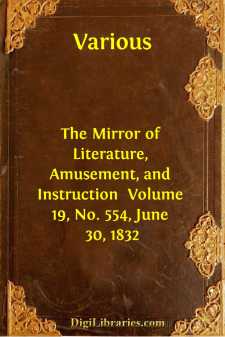Categories
- Antiques & Collectibles 13
- Architecture 36
- Art 48
- Bibles 22
- Biography & Autobiography 813
- Body, Mind & Spirit 142
- Business & Economics 28
- Children's Books 17
- Children's Fiction 14
- Computers 4
- Cooking 94
- Crafts & Hobbies 4
- Drama 346
- Education 46
- Family & Relationships 57
- Fiction 11829
- Games 19
- Gardening 17
- Health & Fitness 34
- History 1377
- House & Home 1
- Humor 147
- Juvenile Fiction 1873
- Juvenile Nonfiction 202
- Language Arts & Disciplines 88
- Law 16
- Literary Collections 686
- Literary Criticism 179
- Mathematics 13
- Medical 41
- Music 40
- Nature 179
- Non-Classifiable 1768
- Performing Arts 7
- Periodicals 1453
- Philosophy 64
- Photography 2
- Poetry 896
- Political Science 203
- Psychology 42
- Reference 154
- Religion 513
- Science 126
- Self-Help 84
- Social Science 81
- Sports & Recreation 34
- Study Aids 3
- Technology & Engineering 59
- Transportation 23
- Travel 463
- True Crime 29
The Mirror of Literature, Amusement, and Instruction Volume 19, No. 554, June 30, 1832
by: Various
Categories:
Description:
Excerpt
We select this Engraving as an illustration of the elaborate sculptural decoration employed in domestic architecture about three centuries since; but more particularly as a specimen of the embellishment of the ecclesiastical residences of that period. It represents a chimney-piece erected in the Bishop's palace at Exeter, by Peter Courtenay, who was consecrated Bishop of Exeter, A.D. 1477, and translated to Winchester, A.D. 1486. He had formerly been master of St. Antony's Hospital, in London.
The bishop was third son of Sir Philip Courtenay of Powderham, knight, (fifth son of Hugh Courtenay, second Earl of Devonshire), who died 1463.
He was educated at Exeter College, Oxford; made archdeacon of Exeter 1453; dean of the same church, 1477.
He died 1491, and was probably buried in the chancel at Powderham, where is an effigy of a bishop inlaid in brass. He built the north tower of Exeter cathedral, and placed in it a great bell, called after him Peter's bell, with a clock and dial: he built also the tower and good part of the church at Honiton (which before was only a chapel, now the chancel). In the windows of the tower are the arms of his parents, now lost; but his paternal arms are on the pillars of the chancel.
The heraldic embellishments of the chimney-piece are as follow:—
"The arms of Courtenay impaled by those of the see of Exeter are in the centre compartment. In that on the left hand is the former coat single, supported by two swans collared and chained. Motto Arma Petri Exon epi. And on the right hand it impales Hungerford, supported by two boars with the Courtenay label round their necks. Motto Arma Patris et Matris.
"Above the centre compartment is the mitre, with the arms of the see, and a label inscribed Colompne ecclesie veritatis p'conie; and here the T is thrice repeated.
"The moulding of the arch is charged with the portcullis and foliage alternately; and on the point are the royal arms in a garter, and supported by two greyhounds.
"The T with the bell appendant occurs on the sides of the centre coat; also the T single and labels, and over the top of the chimney the T and P C for Peter Courtenay.
"The three Sickles and the Sheaf in the angles of the three compartments are the badges of the barons of Hungerford."
Further explanation is necessary, as well as interesting for its connexion with two popular origins—St. Antony's fire, and St. Antony, or "Tantony's Pig."
"The monks of the order of St. Antony wore a black habit with the letter T of a blue colour on the breast. This may sufficiently account for the appearance of that figure among the ornaments of Bishop Courtenay's arms. The following extract from Stow's Survey of London may serve to explain the appendant Bell.
"The Proctors of this hospital were to collect the benevolence of charitable persons towards the building and supporting thereof. And among other things observed in my youth I remember that the officers charged with the oversight of the markets in this city did divers times take from the market people pigs starved, or otherwise unwholesome for men's sustenance: these they did slit in the ear. One of the Proctors of St. Antony tied a bell about the neck, and let it feed among the dunghills, and no man would hurt it, or take it up; but if any gave them bread, or other feeding, such they would know, watch for, and daily follow, whining till they had something given them; whereupon was raised a proverb, 'such a one will follow such a one and whine as it were an Antony pig;' but if such a pig grew to be fat, and came to good liking, as oft times they did, then the Proctor would take him up to the use of the hospital."
"These monks, with their importunate begging were so troublesome, that if men gave them nothing, they would presently threaten them with St....












